
"Violet" Ch Jollygaze Violet Crumble BN,CD,RN,NA,NAJ

"Alyx" CH Ando's Brandy Alexandra BN, RA, NA, NAJ, MXP4, MXPB, MJP2, NFP, T2BP, RATN

"Fievel" BGCH King's Mtn. Fievel Mousekewitz NA, one leg, NAJ, one leg
Agility is one of the fastest-growing dog sports in the country. It’s incredible exercise for both you and your Dandie, and it forges an even deeper relationship between you both. It’s also exciting to watch as your Dandie eagerly works a course. Here’s some information that will help you get started in Agility:
Understand the Basics
Agility is a sport where you direct your dog through a pre-set obstacle course within a certain time limit. Courses typically have between 14-20 obstacles, that may include tunnels, weave poles, tire jumps, seesaws, and pause tables where the dog must stop for a set amount of time. At each trial you and your Dandie will race around unique courses designed for that day. To do this your dog(s) rely solely on the cues and body language you use to direct them on course.
There are three types of AKC agility classes — The Standard Class and The Jumpers with Weaves Class and the Fifteen and Send Time (FAST) Class — offer increasing levels of difficulty to earn Novice, Open, Excellent and Master titles. The Standard Class includes contact objects such as an A-frame and a seesaw.
Make Sure the Sport of Agility Is Right for both You and Your Dandie
Assess your dog’s temperament to be sure he’s right for Agility: Is he highly energetic? Does he enjoy running and responding to instruction? Does he get along well with other dogs? If so, agility could be a great fit.
Training doesn’t only involve your Dandie, you are also critical to the process. You don’t need to be a world class sprinter to do agility, but effective training and good communication are essential.
You can start by taking a class at an AKC club near you. Beginner courses introduce you and your dog to obstacles, and provide the basics of how to compete.
Practicing at home is also important! You can set up your own obstacles, starting with tunnels, which can be collapsed when not in use, and tunnel holders to keep them in place. Weave poles, or evenly spaced upright poles are at-home obstacle that can easily be set up. Training equipment can be purchased online or you can build it yourself with PVC pipes. If you go the DIY route, be sure to follow the specifications in the Regulations for Agility ( AKC Website).
Spend at least 15-20 minutes a day practicing the moves you learn in class and consider using incentives such as treats or toys to help entice your Dandie through the course.
Are you ready? Consider Competing!
Agility can be so thrilling that you might find yourself wanting to go to the next level and actually competing. A great starting place to test your dog’s skills is at an AKC Agility Course Test. The AKC has information on the ACT Test Program
Once you are ready to compete, you will find that there are three types of Agility trials (“competitions”):
- All-breed agility trials for more than 150 breeds and varieties of dogs recognized by the AKC. This is the most common type of trial offered.
- Specialty trials for dogs of a specific breed or varieties of one breed.
- Group trials for dogs of a specific breed group such as herding, working, and so on.
To be eligible to compete in Agility, your dog must be:
- 15 months of age or older.
- Registered with the American Kennel Club or listed with the AKC Indefinite Listing Privilege (ILP) program, which allows unregistered dogs of registerable breeds to compete in AKC Performance and Companion Events.
- Spayed or neutered dogs are eligible to compete.
- In sound health and up-to-date on vaccinations.
